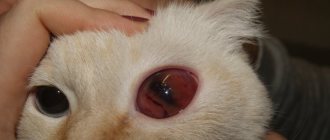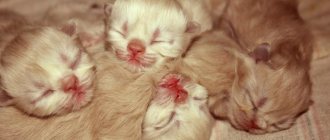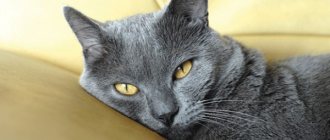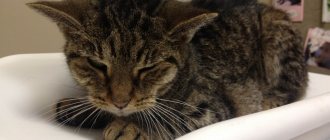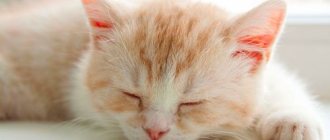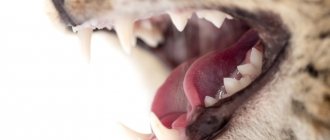The health of a pet is the key to its full, happy life and the joy of its owners. Much depends on the correct conditions of detention, feeding and amount of attention. Understanding the physiology and characteristics of cat development are also important building blocks in ensuring the well-being and longevity of the animal. A pet is not able to complain about being unwell, as a person would. Therefore, the owner’s task is to carefully monitor the behavior of the tailed pet in order to contact a veterinarian in time. Read the article “What food should you feed your cat so that it doesn’t have health problems?”
Pyometra disease in cats, symptoms and treatment of which are the objectives of research by veterinarians around the world, can seriously threaten a cat's life. Studying the symptoms and treatment methods will help prevent a sad outcome and maintain the health of the animal.
What is hidden under the word "pyometra"
Pyometra in a cat, or purulent endometritis, is an inflammatory process inside the uterus. Its main danger is the abundant formation of pus.
The accumulating exudate puts pressure on the internal walls and breaks them over time. Tissue damage leads to acute intoxication of adjacent parts of the abdominal cavity. The affected organs gradually lose their functionality, so the animal, left without timely help, dies.
Diagnosis of the disease
If you suspect a pathological process in the uterus of an animal, you must immediately contact a specialist. The pet is prescribed an ultrasound, during which the doctor examines the condition of the diseased organ - as pathology develops, the size of the uterus increases significantly, its walls thicken, and cysts are visible on the surface. The animal's blood is also analyzed. With pyometra, increased urea, leukocytosis, and hyperglobulinemia are observed. Protein is found in the urine.
If the development of pyometra is suspected, the animal is subjected to ultrasound examination.
Main causes of the disease
The main cause of pyometra in cats is a malfunction of the reproductive organs. It occurs when the following factors are present:
- False pregnancies, difficult childbirth, vaginitis, cysts and other neoplasms. In these cases, purulent endometritis is secondary and develops as a complication.
- Regular use of hormonal medications. Contraceptives used by owners to prevent unwanted pregnancy alter natural hormone levels. As a result, the cyclicity of estrus deviates from the norm, provoking inflammation and oncology.
- A sharp jump in progesterone that occurs after each ovulation. Leads to thickening of the uterine mucosa (endometrium) and a decrease in immunity. The passage of cervical mucus becomes difficult. It accumulates inside and forms pathogenic microflora.
- Bacterial infection acquired during estrus. During this period, the body is very vulnerable, so the animal may become ill due to insufficient hygiene or as a result of infection by a sick mating partner. Also, bacteria can enter the uterus not directly, but through neighboring organs: the intestines or bladder.
Most often, unsterilized animals over 5 years old become ill. The likelihood of developing pathology increases when the recommended frequency of matings is violated and during empty estrus.
If you are overweight or have a too poor diet characterized by a lack of vitamins, even a very young animal can get sick. The only way to avoid this pathology is total removal of the reproductive organs.
Causes of pyometra (purulent inflammation of the uterus, purulent endometritis)
A fairly frequently diagnosed disease, pyometra, is more often detected in older females, but cases of malaise in young and middle-aged individuals are not uncommon.
The following prerequisites for its development are identified:
- Favorable conditions for the development of bacteria in the uterine cavity in the first 2-3 months after estrus. Increased levels of progesterone stimulate and, accordingly, thicken the uterine mucosa. If pregnancy does not occur, it enlarges and cysts form that secrete fluid - ideal conditions for bacterial development. The same excess hormone does not allow the walls of the uterus to push out what has accumulated. At the same time, the leukocytes protecting the cavity do not work: nature’s concern is for the sperm, which can be destroyed by them. As a result, infection occurs.
- Uncontrolled use of hormonal drugs that stop or reduce estrus. This measure often causes changes in the uterus that are suitable for this physiological process. Estrogen, natural or synthetic, enhances the action of progesterone, which can trigger the development of inflammation.
Additional risk factors include violation of hygiene standards during a cat's heat, possible unsanitary conditions during childbirth, uncontrolled mating, impaired immune processes, congenital hormonal changes, and low physical activity. Cats that have not given birth, as well as those that gave birth prematurely or had pathologies, have the greatest predisposition to the disease. The only way to completely protect an animal is by sterilization and removal of the uterus and ovaries.
Symptoms: discharge and other signs
In cats with pyometra, pus from inside the uterus leaks out through the vulva or remains inside. In the first case, the disease is called open. This form is accompanied by the appearance of unpleasant-smelling discharge. Their color and consistency are very diverse, but always deviate from the norm.
The second form of pathology is called closed. It is much more dangerous than the first one, since at an early stage its symptoms are very difficult to detect. Changes noticeable to the owner occur much later, when the endometrial walls become very thin under the pressure of the exudate. At this point, the condition is complicated by the following symptoms:
- acute pain on palpation of the abdomen;
- convulsions and muscle spasms that impair coordination;
- false urge to urinate;
- diarrhea, vomiting and temperature fluctuations (deviation from the norm both up and down).
You should not focus only on these symptoms, as well as the flaky consistency of unusually green or gray discharge. In this case, you may simply not have time to help your pet.
It is much more reliable to start from behavioral changes that occur soon after the onset of the inflammatory process. These include unusual apathy, lethargy, poor appetite and increased thirst.
Also added to these symptoms is a gradual enlargement of the abdomen. If you are not sure about pregnancy, be sure to have your pet checked by a veterinarian.
Symptoms of pyometra in cats
In the initial stages of pyometra, the cat may not show any concern. The general condition does not worsen; it is possible to drink more water, which, as a rule, goes unnoticed. Owners begin to notice alarming symptoms when the cat's hair falls out in clumps to bald spots due to an increased amount of vaginal discharge. The animal becomes anxious, its appetite worsens, and its temperature rises. A clean cat itches until it hurts and loses hair, a symptom that is rarely associated with the accumulation of pus in the body, but rather with the presence of parasites or skin diseases. This is why primary signs often do not attract attention, which can lead to serious consequences.
It is worth paying attention to:
- enlarged abdomen;
- constant thirst with frequent urination;
- brown or white discharge, often cloudy with an unpleasant odor;
- angry restless behavior;
- frequent licking of the abdominal area;
- loss of appetite and excessive vomiting and diarrhea;
- dullness and ruffled coat.
These signs may appear partially or be absent altogether. If the cervix is closed, the pus quickly accumulating inside poisons the body through the bloodstream, and the uterine wall with all its contents may rupture into the abdominal cavity. This situation directly threatens the life of the cat.
Danger and complications
The main danger of the disease is death from acute peritonitis. It occurs when the endometrium ruptures, causing the entire abdominal cavity to fill with pus.
Another possible complication is falling into a coma due to dehydration. In this case, the body is severely depleted, so the likelihood of recovery is minimal. Most often, the animal dies without regaining consciousness.
Taking medications
Taking medications is used in cases where it is necessary to preserve the ability to bear offspring. This method gives the desired effect only in 15% of cases. Treatment with medications helps only at the first stage of the development of the disease; moreover, there is a high risk of relapse after recovery
The purpose of this treatment is to remove purulent masses from the uterus, get rid of bacteria and increase the animal’s immunity. Veterinarians prescribe the following medications:
- oxytocin or prostaglandin - these drugs cause contractions of the uterus and promote the release of pus, but they are used very carefully, since the wrong dosage causes uterine rupture and leads to death;
- Brullomycin - the drug is administered intramuscularly three times a day, 0.2-0.3 ml, the course of treatment is 2.5-3 weeks;
- cloprostenol - administered subcutaneously for 3 days at a dosage of 5 μg of the drug per 5 kg of weight;
- amoxicillin - combined with cloprostenol, the dosage is calculated as follows: per 1 kg of weight, 20 mg of the drug, injected into the muscle for a week;
- ceftriaxone is an antibiotic that is diluted in 5 ml of novocaine, administered intramuscularly, the dosage is selected by a veterinarian;
- To increase immunity, the cat is prescribed immunofan and ribotan, and fortified supplements are included in the diet.
Carrying out diagnostics in the clinic
Diagnosis of pyometra in cats should be carried out strictly in a veterinary clinic. Otherwise, you risk damaging the endometrial walls while palpating the rounded abdomen.
Palpation alone is not enough to confirm the diagnosis. Other required studies include:
- biochemistry and general blood test;
- cytology of scrapings from the cervical canal;
- ECG, X-ray and ultrasound of the pelvis.
Based on the results obtained, not only the presence, but also the amount of exudate is determined. Based on this information, one of two methods is used to treat a mustachioed patient: medication or surgery.
Caring for your pet after surgery
A sick animal requires prevention of possible postoperative complications, pain reduction and additional care. In severe cases, the cat will be left in the clinic for a while. If the operation is successful and there is no threat to life, it is possible to take the animal home. At the same time, follow all the instructions of the veterinarian.
As a rule, the seam is regularly (at least once a day) treated with an antiseptic. To avoid complications, a course of antibiotics is prescribed. The cat will have to wear a blanket until it heals completely.
If organs are removed by laparoscopy, intradermal sutures are applied; special care is not required.
Even a difficult postoperative period in a cat after removal of the uterus can be alleviated by the use of special medicinal, wound healing and immunostimulating agents:
- Injectable Imunofan for cats whose price is low, but the result is proven: increasing the antiviral and antibacterial resistance of the weakened animal’s body. In the period after illness and surgery, it will have an anti-inflammatory effect and reduce possible side effects of medications. According to research, Immunofan for cats does not cause allergic reactions; you just need to take into account the required dose.
- Universal Hemobalance for cats is used for prevention and treatment, incl. and after undergoing surgical interventions. The drug will provide the sick animal with the necessary substances, restore the liver, and promote digestive and hematopoietic processes.
- Preventive Roncoleukin for cats, the price of which will not frighten even the thrifty owner, will reduce the likelihood of postoperative complications. If the condition is unstable, it will improve the pet’s condition, shorten the recovery period, and promote rapid tissue regeneration.
- A unique Traumatine for cats is recommended for all owners of tailed cats. It will help relieve pain, disinfect, and eliminate the effects of intoxication in the cat’s body. After surgery to remove the uterus, the pet will come to its senses much faster. Trauma for cats, the price of which is only about 300 rubles per bottle, will eliminate pain and the consequences of shock.
- External Aluminum spray for animals is intended for the treatment of wounds and sutures. Promotes rapid healing, has an anti-inflammatory effect. The cat is not allowed to lick the film. The duration of use after hysterectomy depends on the speed of healing and does not exceed 10 days.
- The drug ASD 2 for cats has a pronounced antiseptic effect; it should be used with caution to avoid toxic effects as prescribed by a doctor.
It should be noted that before using any drug, you should clarify the need and exact dosage with your veterinarian.
Drug treatment method
In 85% of cases, medication is ineffective. For this reason, the main treatment method is surgery. It is recommended even for breeding animals, since after improvement in health there is still a high probability of relapse. In this case, kittens may be born with congenital abnormalities.
To carry out drug therapy, your pet must have a strong immune system and good health. The antibiotics and hormonal drugs used weaken the body's defenses and stimulate uterine contractions. All this is fraught with:
- miscarriages and abnormal development of fetuses;
- endometrial rupture and peritonitis;
- exacerbation of chronic pathologies;
- infertility;
- re-development of inflammation upon the onset of a new estrus or shortly after it.
It is much safer to operate on the animal immediately after diagnosis. Otherwise, the body, weakened by the disease, simply will not survive anesthesia during the next relapse, and all the efforts of the surgeon will be useless.
Prevention of pyometra
The best way to prevent pyometra in a cat is to have it spayed early (about 8 months). If this option is not suitable, you should avoid hormonal drugs for estrus, using only those based on soothing herbs. Owners often look for causes of baldness in cats, treatment of which may be ineffective due to incorrect diagnosis. This is not surprising, because the primary signs of pyometra are sometimes invisible, but the secondary ones are already critical. Attentive attitude to the pet, regularly scheduled mating, monitoring of childbirth and the postpartum period will help maintain the health of the furry female for a long time. You can read about mating Scottish Fold cats here.
When surgery cannot be avoided
If a cat is diagnosed with closed pyometra, then surgery is mandatory. Other indications for emergency surgery include neoplasms and uterine rupture.
The operation involves removing not only the uterus, but also both ovaries, which completely eliminates relapses. When performing it, the laparoscopic method is increasingly used, which does not require large incisions and is limited to the application of intradermal sutures.
Carrying out the intervention
The procedure for removing reproductive organs is similar to conventional castration, but carries much more risks. This is due to purulent exudate, complicating the surgeon’s work.
If there is too much of it, the endometrium may rupture during surgery. For this reason, the animal is prescribed hormonal drugs that reduce internal pressure due to the partial removal of pus.
Other complications include internal bleeding and negative reactions to surgical sutures. In the latter case, the operation must be repeated.
You should not be afraid of the listed risks, since the consequences of the pathology itself are much more serious.
The same applies to general anesthesia. The dosage is selected individually for each patient, excluding a negative reaction to the administered drugs.
Recovery period: care and nutrition
After the pyometra is removed, a special bandage is put on the cat to protect the sutures from damage. The recovery period takes about 10-20 days, but the first improvements are noticeable already on the 2nd day. Until this point you need to:
- Maintain a fasting diet for 24 hours so as not to provoke vomiting.
- Smoothly switch to a gentle diet after the appearance of appetite. When feeding naturally, all foods should be ground or cut into small pieces. When dry feeding, wet canned food and granulated food for sterilized animals are suitable.
- Monitor the amount of fluid you consume to prevent dehydration.
- Provide a comfortable and warm place on the floor. Due to lack of coordination, jumping on high surfaces can result in injury.
Taking symptomatic medications and antibiotics is discussed individually. The same applies to seam care. Most ointments slow down tissue regeneration, so most often it is enough to prevent contamination of the postoperative wound and monitor its condition. If the stitches come apart, pus, blood or inflammation appears, it is recommended to contact a veterinary clinic.
Surgical treatment of pyometra
Otodectosis in cats: treatment, drops, drugs
The surgical method for treating pyometra is as follows: the cat's uterus is removed, as well as both ovaries. Most often, this method is the only chance to save the animal.
The surgical method of treating the disease completely eliminates the possibility of recurrence of the disease in the future.
Today, pyometra is removed using the laparoscopic method, and intradermal sutures are applied. The rehabilitation course after surgery consists of IVs and wearing a special blanket, which, taking into account the body structure of cats, will prevent the animal from unnecessary injury.
The open form of pyometra facilitates early diagnosis
In the normal course of the postoperative period, the animal will be healthy within 1-2 weeks. In addition, with this method of treatment, the pet will be insured against a possible recurrence of the disease, as with the medication method.
Surgical intervention
Surgery is the most effective method of treatment
Surgery is the most effective way to treat pyometra. The cat is given general anesthesia, after which the uterus with pus and ovaries are carefully removed. A timely operation increases the chance of recovery to 90-100%.
The main advantage of this method of treatment is the absence of future relapses, but cats with the uterus removed will no longer be able to bear offspring. Veterinarians recommend sterilizing animals that are not involved in breeding. The optimal age for the operation is 7-8 months (or after the first heat), but sterilization is carried out at a later age.
The cost of such an operation depends on many factors. At the state veterinary station, the price is noticeably lower than in private clinics. The cost also depends on the weight of the animal (the amount of anesthesia administered depends on the body weight). On average, the cost of surgery to remove pyometra is 2000-3500 rubles.
